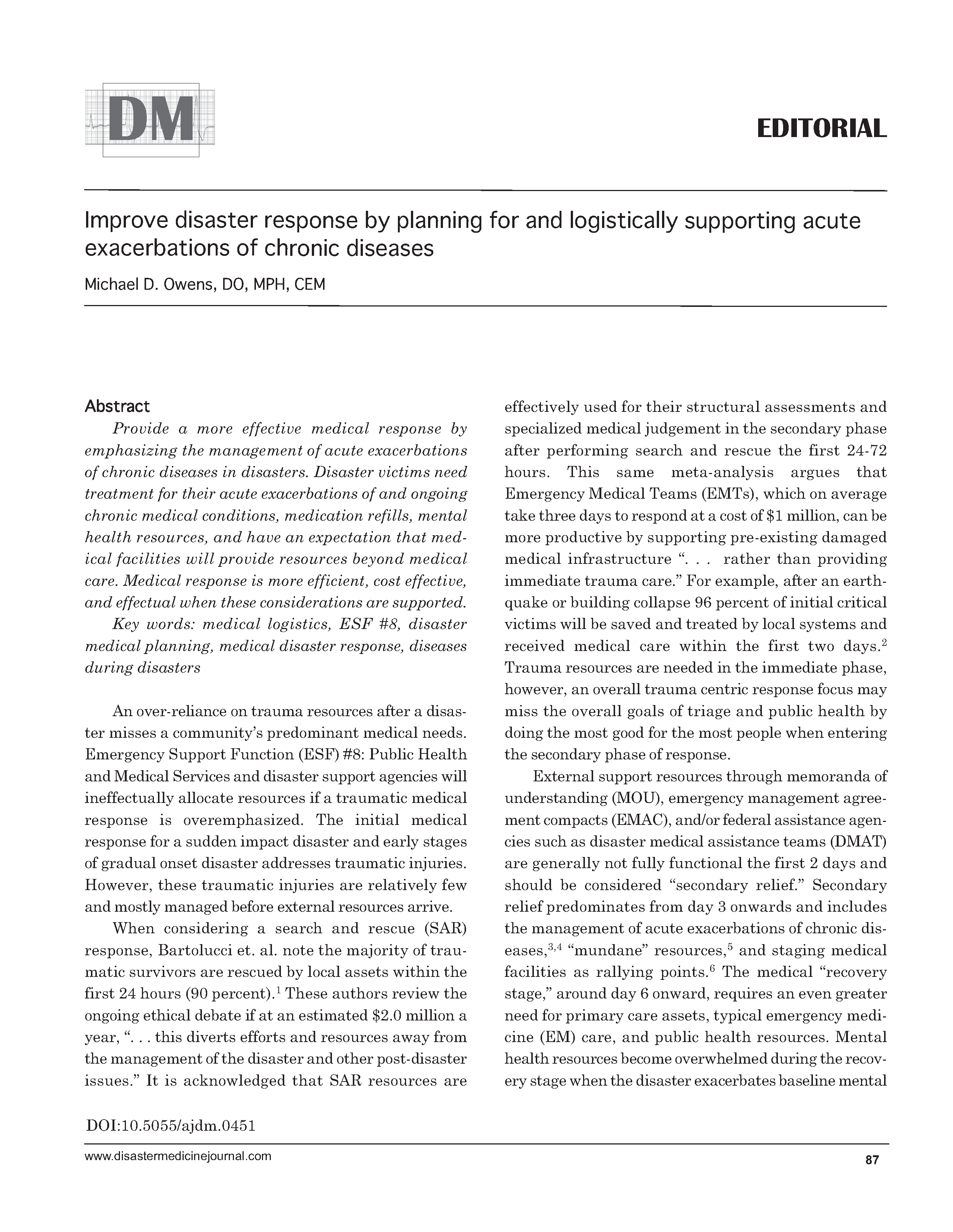Improve disaster response by planning for and logistically supporting acute exacerbations of chronic diseases
DOI:
https://doi.org/10.5055/ajdm.0451Keywords:
medical logistics, ESF #8, disaster medical planning, medical disaster response, diseases during disastersAbstract
Provide a more effective medical response by emphasizing the management of acute exacerbations of chronic diseases in disasters. Disaster victims need treatment for their acute exacerbations of and ongoing chronic medical conditions, medication refills, mental health resources, and have an expectation that medical facilities will provide resources beyond medical care. Medical response is more efficient, cost effective, and effectual when these considerations are supported.
References
Bartolucci A, Walter D, Redmond T: Comparative Review on the Cost-Effectiveness Analysis of Relief Teams’ Deployment to Sudden-Onset Disasters. Prehosp Disaster Med. 2019; 34(4): 415-421. DOI: 10.1071/S1049023X19004540.
Landesman LY: Chapter 5: Health Assessment, Vulnerability Analysis, Risk Assessment, and Rapid Health Assessment. In: Landesman LY, (ed.): Public Health Management of Disasters: The Practice Guide. 3rd ed. American Public Health Association. 2012: 121-122.
Tamariz L, Cely C, Palacio A: The Forgotten Need of Disaster Relief. Disaster Med Public Health Prep. 2018; 12(3): 284-286. DOI: 101017/dmp.2017.67.
Noji EK: Disaster epidemiology. Emerg Med Clin North Am. 1996; 14(2): 289-300. DOI: 10.1016/s0733-8627(05)70252-2.
Abeysinghe S, Leppold C, Ozaki A, et al.: Disappearing everyday materials: The displacement of medical resources following disaster in Fukushima, Japan. Soc Sci Med. 2017; 191: 117-124. DOI: 10.1016/j.socscimed.2017.09.011.
Charney RL, Rebmann T, Esguerra CR, et al.: Public perceptions of hospital responsibilities to those presenting without medical injury or illness during a disaster. J Emerg Med. 2013; 45(4): 578-584. DOI: 10.1016/j.jemermed.2013.05.010.
Infographics: Chronic Diseases in America. Centers for Disease Control and Prevention. Available at: https://www.cdc.gov/chronicdisease/tools/infographics.htm. Accessed February 12, 2023.
Tomio J, Sato H, Mizumura H: Interruption of medication among outpatients with chronic conditions after a flood. Prehosp Disaster Med. 2010; 25(1): 42-50. DOI: 10.1017/s1049023x00007652.
Islam T, Munter P, Webber LS, et al.: Cohort study of medication adherence in older adults (CoSMO): extended effects of Hurricane Katrina on mediation adherence among older adults. Am J Med Sci. 2008; 336(2): 105-110. DOI: 10.1097/MAJ.0b013e318180f175.
Iskander J, McLanahan E, Thomas JD, et al.: Public Health Emergency Response Lessons Learned by Rapid Deployment Force 3, 2006-2016. Am Public Health. 2018; 108(S3): S179-S182. DOI: 10.2015/AJPH.2018.304496.
Chan EY, Sondrop E: Medical interventions following natural disasters: missing out on chronic medical needs. Asia Pac J Public Health. 2007; 19 Spec No: 45-51. DOI: 10.1177/101053950701901S08.

Published
How to Cite
Issue
Section
License
Copyright 2007-2025, Weston Medical Publishing, LLC and American Journal of Disaster Medicine. All Rights Reserved.

